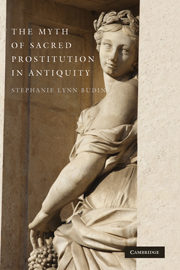Book contents
- Frontmatter
- Contents
- Acknowledgments
- Abbreviations
- THE MYTH OF SACRED PROSTITUTION IN ANTIQUITY
- 1 Introduction
- 2 The Ancient Near Eastern Data
- 3 The So-Called “Evidence”
- 4 Herodotos
- 5 In the Footsteps of Herodotos: Lucian and “Jeremiah”
- 6 Pindar Fragment 122
- 7 Strabo, Confused and Misunderstood
- 8 Klearkhos, Justinus, and Valerius Maximus
- 9 Archaeological “Evidence” from Italy
- 10 The Early Christian Rhetoric
- 11 Last Myths
- Bibliography
- Index
- Index Locorum
11 - Last Myths
Published online by Cambridge University Press: 18 August 2009
- Frontmatter
- Contents
- Acknowledgments
- Abbreviations
- THE MYTH OF SACRED PROSTITUTION IN ANTIQUITY
- 1 Introduction
- 2 The Ancient Near Eastern Data
- 3 The So-Called “Evidence”
- 4 Herodotos
- 5 In the Footsteps of Herodotos: Lucian and “Jeremiah”
- 6 Pindar Fragment 122
- 7 Strabo, Confused and Misunderstood
- 8 Klearkhos, Justinus, and Valerius Maximus
- 9 Archaeological “Evidence” from Italy
- 10 The Early Christian Rhetoric
- 11 Last Myths
- Bibliography
- Index
- Index Locorum
Summary
COROLLARY
There is an important corollary to the sacred prostitution myth. According to this corollary, sacred prostitution never existed, but was primarily an invention of the Victorians, especially Sir James G. Frazer in his work The Golden Bough, based on biased Classical sources, notably Herodotos. Thus for G. Leick, “[T]he ‘sacred prostitute,’ who engages in sex as a magical rite in the context of some fertility cult or officiates in the rites of Inanna/Ištar, belongs to the ‘Golden Bough’ school of historical anthropology.” The fullest discussion of this corollary is presented by J. Assante:
Prostitutes fornicated with strangers in and around the temple precincts, in the city streets, squares and taverns, while highly specialized hierodules copulated with kings in beds elaborately prepared for sacred marriage rituals. This vision was largely derived from the 19th century view of ancient Mesopotamia as a forum of naive and primitive sexual freedom allowable before the Old Testament prophets imposed their more austere mores. The notion of Mesopotamia's sexual freedom … was anachronistically based in the 19th century version of it as an exclusively male preserve. Philologists and art historians read the unmarried women attested in cuneiform as prostitutes, sacred or secular…. Aside from the avant-garde, which was fast legitimizing erotica as a worthwhile academic pursuit, a number of historical “authorities,” unduly influenced scholars of the ancient Near East. Chief among them was Herodotus…. The deviancy of Mesopotamian sexual activity seemed confirmed by the Old Testament writers who accused idolaters of harlotry and adultery.
- Type
- Chapter
- Information
- The Myth of Sacred Prostitution in Antiquity , pp. 287 - 336Publisher: Cambridge University PressPrint publication year: 2008

